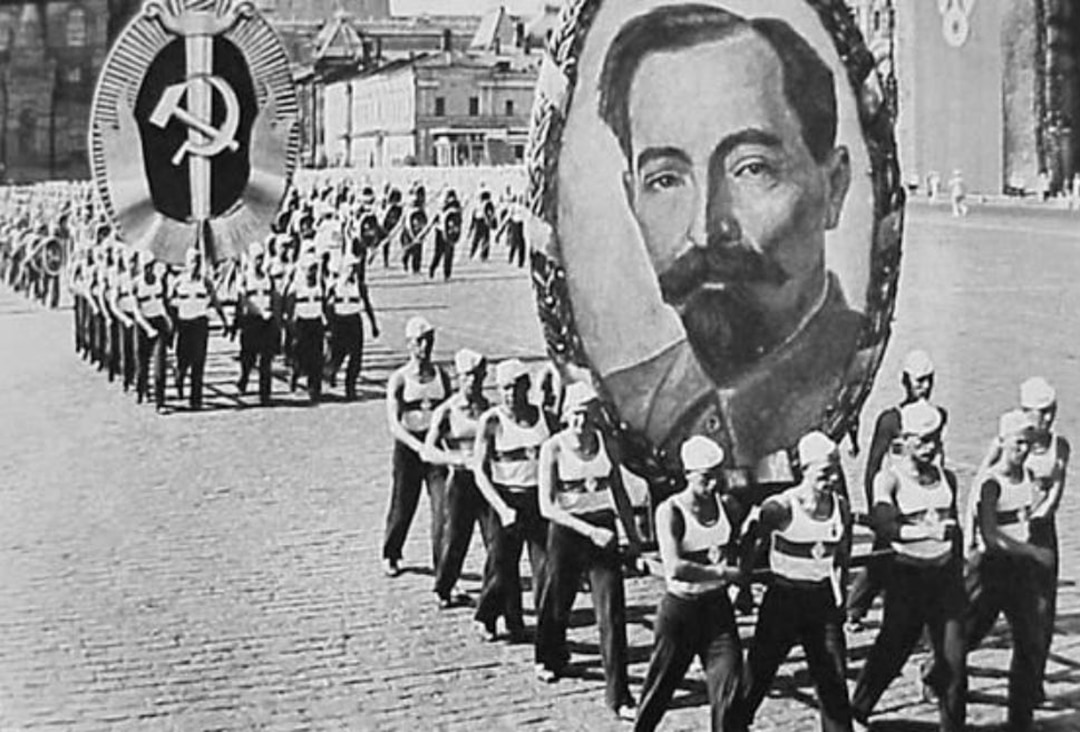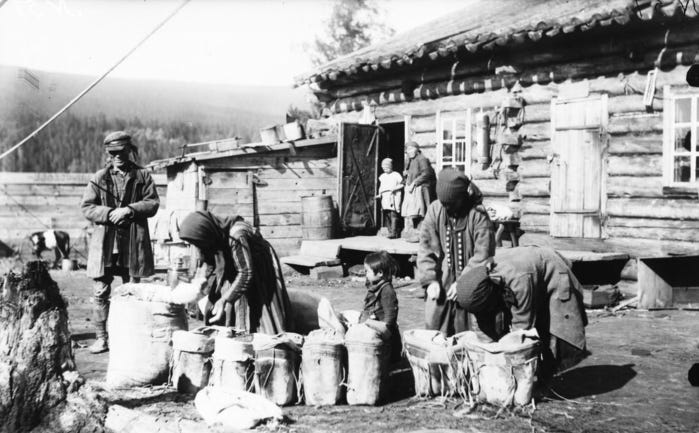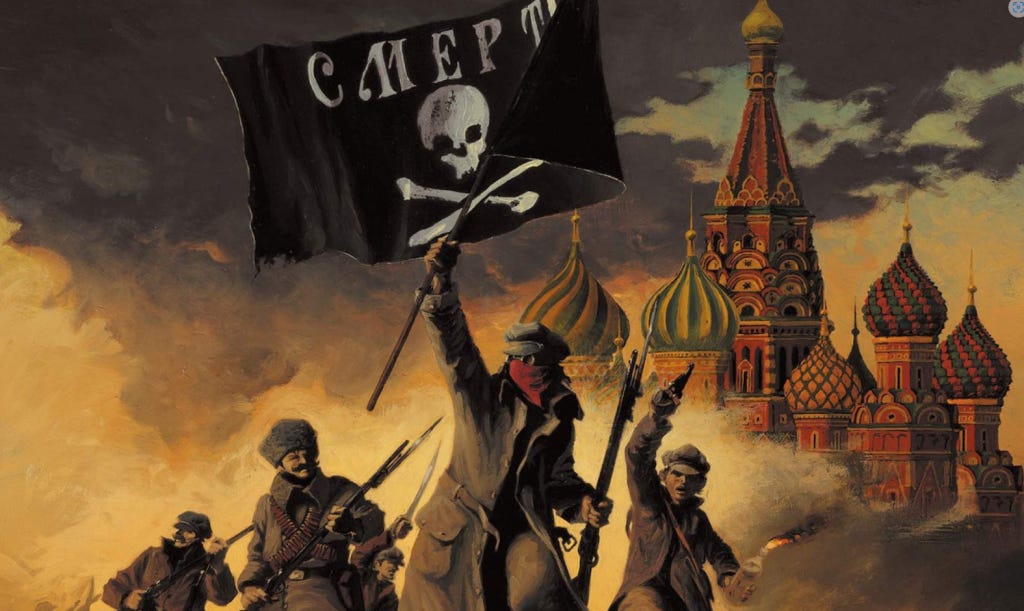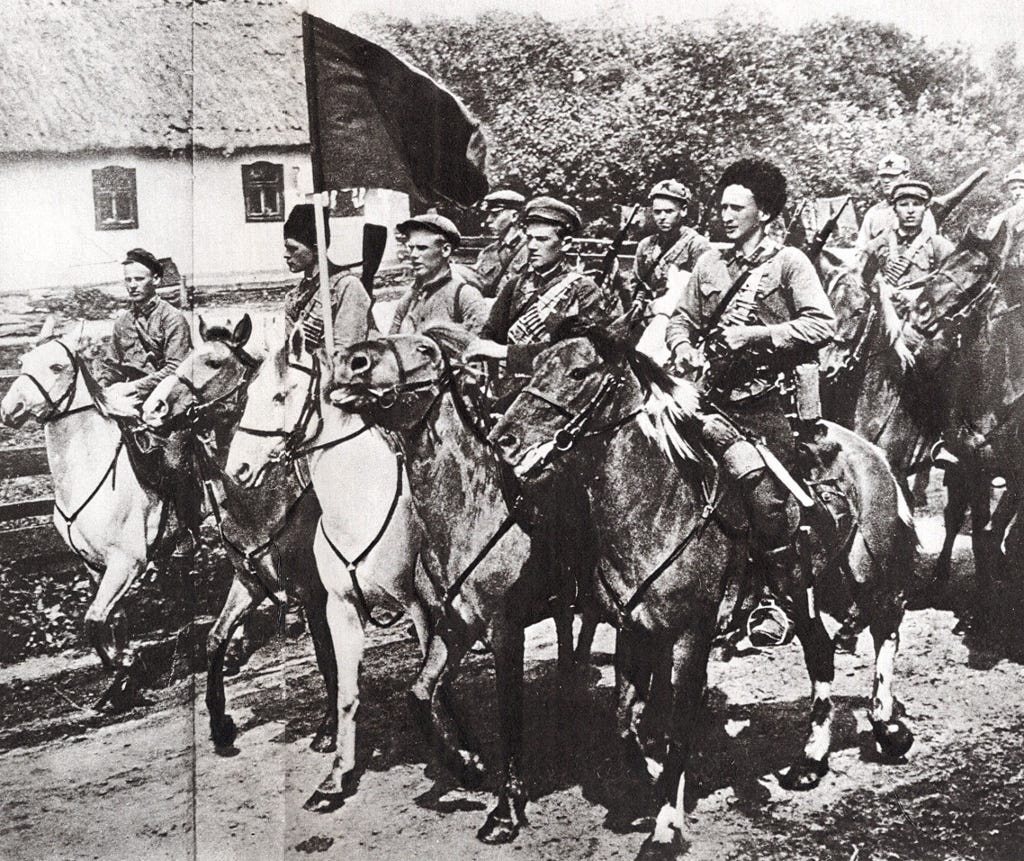Subscribe to Zero-Sum Pfear & Loathing



by Paul Cudenec | Mar 30, 2024
An authentic mood of revolt had been swelling up in Russia for some time before 1917, with a previous attempted revolution in 1905-06 violently repressed by the tsarist regime.
A great inspiration behind this mood was the back-to-the-land Christian anarchism of the revered Russian novelist and thinker Leo Tolstoy, [11] author of War and Peace.
Contemporary observer Anatole Leroy-Beaulieu wrote in 1910: “We know that Tolstoy’s ideas about land are those of the majority of Russian peasants”. [12]
This radical outlook regarded the earth as a common treasury for all, like air and water: the land belonged to those who dug it and not to speculators.
“Land and freedom” was the slogan that captured the imagination of peasant families, whose ideal was the mir, a village community based on traditional values and involving democratic decision-making, sharing of resources and mutual aid.
These peasants lived simply, healthily and largely beyond the reach of both central state power and, crucially, of the money-based economy. [13]

The same sort of thinking, based on popular self-determination, was even behind the creation of the Soviets – workers’ councils – that were later to give the communist empire its name.
Voline, who was on the ground in 1905-06 when the first of these was set up in St Petersburg, insists that no party or “leader” was involved.
“It emerged spontaneously, as the result of a collective agreement in a small and private group that came together by chance”. [14]
He describes how the subsequent general strike in what was then the Russian capital was, likewise, entirely spontaneous and self-organised, with no political party having the chance to grab control of it.
This anarchic spirit emerged again in 1917-18, he says. “Its influence, very weak at the start, grew as events developed”. [15]
The aim was “to transform the economic and social basis of society without making use of a political state, a government, a ‘dictatorship’ of any kind, in other words to bring about the Revolution and resolve its problems not by means of politics and the state, but by the free and natural, economic and social, activities of associations of the workers themselves, after overturning the last capitalist government”. [16]

Voline describes how ordinary people gravitated towards these sorts of ideas all across the Russian empire, by some sort of process of natural shared intuition.
“When the working masses have the possibility of thinking, searching and acting freely, they see more or less the same path, whatever the locality, the mood and even – let’s add – the era, if we refer back to previous revolutions. Independently of all other reasoning, this must lead us to believe that on the whole this path is the right one, the just one, the true path for the workers“. [17]
This true path of revolt proved particularly popular in Ukraine, under the inspiring leadership of anarchist warrior Nestor Makhno.
His insurrectionary army initially fought on the side of the Bolsheviks against anti-revolutionary Ukrainian nationalists and Whites.
But Voline explains that commitment to freedom ran deep in the blood of the Makhnovshchina, and, with their great “organic” vitality, [18] they were not prepared to bow to repression from any direction.
He describes how their army advanced at lightning speed – flying, on their leading two-horse cart, a large black flag embroidered with the words “Liberty or Death”. [19]
Whenever he took over a town, Makhno put up posters declaring, more or less: “Your town is occupied, temporarily, by the insurrectionary revolutionary army (Makhnovist). This army is at the service of no political party, of no power, of no dictatorship. On the contrary, it aims to liberate the region from all power, all dictatorship”. [20]

Voline continues: “Total freedom of speech, press, assembly and association, of all kinds and for everybody, was immediately proclaimed”. [21]
But, of course, freedom, mutual aid and self-determination were the very last things the Bolsheviks were going to welcome. Their aim was to establish a centralised workers’ state, the long-cherished “dictatorship of the proletariat”. [22]
Voline recalls that he and his friends made desperate attempts to alert fellow Russians to the “imminent danger for the real Revolution” if the Bolsheviks established control. [23]
The weekly anarchist paper Goloss Trouda warned in 1917: “Instead of a free unification from below, we will see the establishment of an authoritarian, political state apparatus which will act from above and set about crushing everything with its iron fist”. [24]
By the end of 1918, the Bolsheviks were seriously worried by the growing influence of the pro-freedom, anarchist, spirit, says Voline. “From 1919 until the end of 1921 they were forced to conduct a very severe struggle against the advance of this idea: a struggle at least as bitter and lengthy as that against the forces of reaction”. [25]
Part of this assault on authentic revolutionaries involved the use of smears, always a favourite tool in such circles.
Anarchist thinkers were dismissed as “utopian”, “irresponsible dreamers”, “abstract philosophers” or “mystics” whose ideas bore no relation to “real life”, while anarchist activists were depicted as “enemies of the public”, “fools”, “bandits”, “criminals” or “terrorists”. [26]

The Makhnovshchina were described by the Bolsheviks as “rioting kulaks”, [27] while Makhno himself (pictured) was labelled a “looter”, a “murderer” [28] and, despite the presence of numerous Jews in his ranks, an “anti-semite”. [29]
The communists’ propaganda assaults paved the way for physical attacks, with activists set upon, books burned and premises pulled down in what Voline calls “a real fury of repression”. [30]
“No sooner had they got to power than they were planning the suppression of the popular movement by all the means at their disposal: press campaigns and meetings, smears, tricks, traps, bans, raids, arrests, acts of violence, ransacking of buildings, murders – they stopped at nothing”. [31]
When their initial repression and censorship failed to stem the spread of anarchist ideas, they started using even more violent means, systematically throwing them in prison, outlawing them, putting them to death.
Voline says the conflict in some parts of the Russian empire essentially amounted to civil war: “In Ukraine, notably, this state of war lasted more than two years, obliging the Bolsheviks to mobilise all their forces to stifle the anarchist idea and crush the popular movements it had inspired”. [32]
The communist repression in Ukraine got underway in April 1919, in reaction to the regional congress of peasants, workers and partisans held in Makhno’s home town of Huliaipole. The delegates from 72 districts represented a population of more than two million people.
Voline writes that he regrets no longer having access to the minutes of the congress – “they show quite clearly with what drive and, at the same time, with what spirit of wisdom and forward thinking the people sought, in the Revolution, their own path, their own popular forms of the new life”. [33]
Towards the end of the event a telegram arrived from a Bolshevik military commander declaring the congress to be “counter-revolutionary” and its organisers “outside the law”, he explains.
“This was the first direct attack by the Bolsheviks on the freedom of the region. It was at the same time a declaration of war on the Insurrectionary Army”. [34]
The next month the Bolsheviks tried to have Makhno murdered [35] then in June 1919 they launched a military attack on his rear while he was holding back the White army of Cossacks led by Anton Denikin – a real stab in the back of what were supposed to be their allies.

“Bursting into the villages, the Bolsheviks seized activists and executed them on the spot; they destroyed the free communes and the other organisations”. [36]
The attack was ordered by none other than Leon Trotsky (pictured), today such a hero to the leftists of the Socialist Workers Party and similar organisations, who is described by Voline as intellectually limited but “inordinately arrogant and malicious”. [37]
Trotsky next ordered that no further arms should be supplied to Makhno’s army in its struggle against Denikin and then, “with monstrous cynicism, with unimagineable insolence and hypocrisy”, [38] claimed that his anarchist rivals had betrayed the revolution by deliberately letting Denikin advance.
Interestingly, and relevantly since we are here interested in the phenomenon of communism as a whole, Voline goes on to explain that a similar “tactic” was later used by communists during the Spanish Civil War, when one of their brigades was manning the front against Franco alongside an anarchist brigade of some 1,500 men.
The communists deliberately and secretly abandoned their position in the middle of the night, allowing the fascists to move into the breach and surround the anarchists, of whom 1,000 were unable to escape and were duly massacred.
“The following day the ‘communists’ accused the anarchists of having betrayed them and opened the front to Franco”. [39]
Time and time again, Voline observes, communists use “brutal force, based on deceit and imposture” [40] to get their way.
For all his heroics, Makhno was finally defeated by the Bolsheviks, fleeing the country with a gaggle of followers.
Worse still, the freedom of the Ukrainian peasants was broken by the communist dictatorship and its massacres, intended to destroy for ever their rebellious spirit and ensure that they would never rise up again.
Outside Ukraine, the most notorious example of communist repression was of the Kronstadt rebellion of 1921, in which sailors and civilians rose up against increasingly authoritarian Bolshevik rule, calling for freedom of speech, press and assembly. [41]

To cut a long story short, the rebellion was eventually crushed by the Bolsheviks in what Voline describes as “a brutal massacre, a real bloodbath”. [42]
But the important thing to retain is that, as in Ukraine, the Bolsheviks were not actually repressing “counter-revolutionaries”, as they claimed, but people and groups who were more radical than them, who wanted a Third Revolution to achieve a genuinely free Russia.
It was the Bolsheviks themselves who were the real counter-revolutionaries, the real betrayers of the people’s movement, simply taking advantage of its revolutionary energy to grab power.
They then ruthlessly destroyed anyone seeking to take that power back into the hands of the people.
Their authoritarian gang “crushed and subjugated the working class to exploit it, under new forms, in its own interests”, judges Voline. [43]
“Their system depends on deception and violence, as in any authoritarian and state system, which necessarily dominates, exploits and oppresses.
“The statist ‘communist’ regime is just another kind of fascist regime”. [44]

[11] https://orgrad.wordpress.com/a-z-of-thinkers/leo-tolstoy/
[12] La Revue des deux mondes, 15 décembre, 1910 cit. Pierre Thiesset, ‘Tolstoï contre les bolcheviks’, Brasero: revue de contre-histoire, No 1, novembre 2021 (Paris: L’Échappée), p. 93.
[13] Thiesset, p. 94.
[14] Voline, La Révolution Inconnue: de 1905 à Octobre (Paris: Pierre Belfond, 1972), p. 80.
[15] Voline, de 1905 à Octobre, p. 154.
[16] Voline, de 1905 à Octobre, p. 155.
[17] Voline, La Révolution Inconnue: la fin de Cronstadt et l’insurrection en Ukraine (Paris: Pierre Belfond, 1972), p. 68.
[18] Voline, la fin de Cronstadt et l’Insurrection en Ukraine, p. 121.
[19] Voline, la fin de Cronstadt et l’Insurrection en Ukraine, p. 102.
[20] Voline, la fin de Cronstadt et l’Insurrection en Ukraine, p. 122.
[21] Voline, la fin de Cronstadt et l’Insurrection en Ukraine, p. 124.
[22] Voline, de 1905 à Octobre, p. 155.
[23] Voline, de 1905 à Octobre, p. 201.
[24] Voline, de 1905 à Octobre, pp. 209-10.
[25] Voline, de 1905 à Octobre, p. 154.
[26] Voline, de 1905 à Octobre, p. 231.
[27] Voline, la fin de Cronstadt et l’Insurrection en Ukraine, p 85.
[28] Voline, la fin de Cronstadt et l’Insurrection en Ukraine, p. 46.
[29] Voline, la fin de Cronstadt et l’Insurrection en Ukraine, pp. 196-97.
[30] Voline, La Révolution Inconnue: du pouvoir bolshéviste à Cronstadt (Paris: Pierre Belfond, 1972), p. 48.
[31] Voline, de 1905 à Octobre, p. 171.
[32] Voline, de 1905 à Octobre, p. 154.
[33] Voline, la fin de Cronstadt et l’Insurrection en Ukraine, pp.79-80.
[34] Voline, la fin de Cronstadt et l’Insurrection en Ukraine, p. 80.
[35] Voline, la fin de Cronstadt et l’Insurrection en Ukraine, p. 86.
[36] Voline, la fin de Cronstadt et l’Insurrection en Ukraine, p. 89.
[37] Voline, la fin de Cronstadt et l’Insurrection en Ukraine, p. 89.
[38] Voline, la fin de Cronstadt et l’Insurrection en Ukraine, p. 92.
[39] Voline, la fin de Cronstadt et l’Insurrection en Ukraine, p. 93.
[40] Voline, la fin de Cronstadt et l’Insurrection en Ukraine, p. 165.
[41] Marie Isidine, ‘La Vérité sur Kronstadt’, Braséro No 1, p. 26.
[42] Voline, la fin de Cronstadt et l’Insurrection en Ukraine, p. 24.
[43] Voline, de 1905 à Octobre, p. 141.
[44] Voline, du pouvoir bolshéviste à Cronstadt, p. 87.

The introduction to this essay, Fake resistance, can be found here and three further parts will follow:
Industrial slavery
A repugnant racket
Flawed and despotic
Alternatively, the whole thing can be downloaded as a free pdf booklet here.